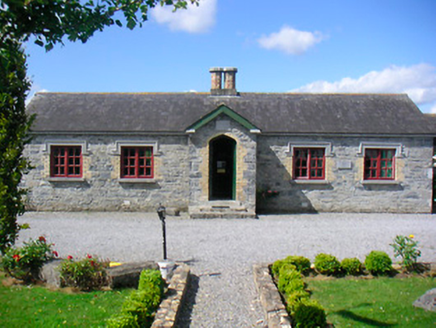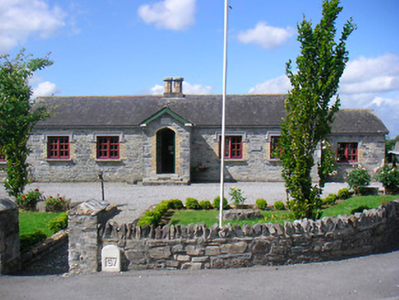Survey Data
Reg No
15314009
Rating
Regional
Categories of Special Interest
Architectural, Artistic, Historical, Social
Original Use
School
In Use As
Community centre
Date
1840 - 1850
Coordinates
209050, 246601
Date Recorded
22/07/2004
Date Updated
--/--/--
Description
Detached five-bay single-storey school house, dated 1844, having a single-bay gable-fronted entrance porch to the centre of the main façade (east) and single-bay recessed wings to either gable end (north and south). Now in use as a heritage centre and community centre. Pitched natural slate roofs with clay ridge tiles and a central pair of Tudor Gothic style brick chimneystacks (on octagonal plan with cut-stone coping over). Coursed rubble limestone walls with brick dressing to openings, originally rendered. Square-headed window openings having hoodmouldings over and cut stone sills and replacement timber casement windows. Tudor-arched doorcase with brick dressings to projecting porch having replacement timber door. Cut stone plaque above doorway. Located in prominent position to the south of the village of Glassan. Set back from road in own grounds with rubble limestone wall to road-frontage.
Appraisal
A well-proportioned and attractive school building retaining its original character and much of its original fabric despite recent conversion to a heritage centre. The Tudor chimneystacks (on octagonal plan) are an interesting feature. The Tudor Revival style was a popular architectural style adopted for many school buildings (sometimes called the Collegiate Gothic style), gate lodges and institutional buildings (such as workhouses and lunatic asylums) in Ireland during the mid-to-late nineteenth-century. It is of social interest as one of the earliest purpose-built schools in the locality and has important historical connections with the Temple-Handcock Family of nearby Waterstown House (15314014), who originally funded its construction and supported its upkeep until the late nineteenth-century. According to local sources the school was closed between 1897 and 1905, as the Temple-Handcock Family could no longer afford its upkeep. In 1905 a concert was arranged to raise funds at which the famous tenor Count John McCormack from Athlone was the star performer. The carved stone plaque, hoodmouldings and moulded brick chimneystacks are of artistic merit. This structure is a feature building in the town and is an attractive feature on the main approach road into the village from the south.



